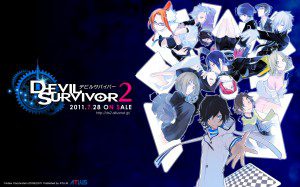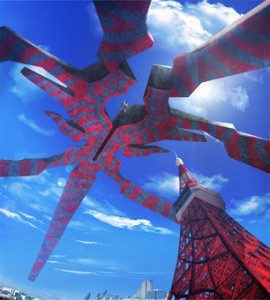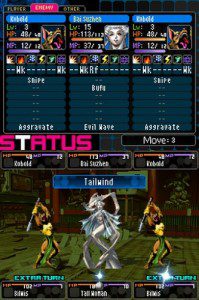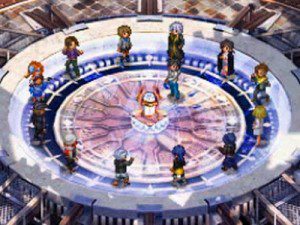 When it comes to long standing JRPG franchises, Shin Megami Tensei might seem like the “red-haired stepchild” of the bunch. Not as globally beloved as Pokemon, nor as ever-present as Final Fantasy, but still a powerful force in the JRPG community. It has its well-received titles- the acclaimed Persona series, side stories like Nocturne and Digital Devil Saga being a few of them- and is often lauded for its blend of traditional battle elements with compelling stories. But it generally flies under the radar of mainstream US audiences due to a lack of flashy cutscenes, over-the-top graphics, and “cookie cutter” characters.
When it comes to long standing JRPG franchises, Shin Megami Tensei might seem like the “red-haired stepchild” of the bunch. Not as globally beloved as Pokemon, nor as ever-present as Final Fantasy, but still a powerful force in the JRPG community. It has its well-received titles- the acclaimed Persona series, side stories like Nocturne and Digital Devil Saga being a few of them- and is often lauded for its blend of traditional battle elements with compelling stories. But it generally flies under the radar of mainstream US audiences due to a lack of flashy cutscenes, over-the-top graphics, and “cookie cutter” characters.
I was one of those mainstream US gamers before I played SMT: Devil Survivor in 2009. I had heard of Persona, but hadn’t played it due to lack of time for console gaming (and a raging addiction to World of Warcraft). The fact that the title was available for the Nintendo DS, and an alternative to the Pokemon games I had been playing on the go, grabbed my attention enough to warrant purchase. I was expecting an entertaining story involving demons and suspense- what I got was an experience in gaming far beyond anything I had ever anticipated. I logged more hours in Devil Survivor than in any other game that year, my completist nature calling on me to see every story and fuse every demon. I still refer to it as one of my favorite games of all time.
So imagine my delight when a sequel was announced. Easily the most-anticipated game of my year, I managed to acquire a copy a full week ahead of release date, eager to once more jump into the wide world of demon-fusing and dystopian survival. Plus this time I had a gigantic DSi XL to play it on. Unfortunately, the game wasn’t fully able to live up to my own hype.

As with most MegaTen games, you are the Protagonist- a high school student in modern day Japan. You have your friends, your classes, and a style all your own. One day you sign up for a service called Nicaea, which promises to upload “death clips” directly to your phone- these clips can be of anyone, even yourself, which has made the ‘service’ extremely popular. Of course, your own death clip is the first you see (a bloody train accident in central Tokyo), but rather than bite the proverbial dust, your impending doom is halted by the arrival of demons from some great Otherworld. Following a battle in which you forge contracts with the demons so they fight for you, you discover the world has changed.
Earthquakes have ravaged the country, toppling cities and plunging Japan (if not the entire world) into a decline. Your demons are your only chance at fighting against the anarchy at first, as you make your way through ruined Tokyo. Similar to the first game, these early hours are the only similarity, as the story diverges from a war between heaven and hell into something…else. Shadowy government organizations, alien entities, more death clips and rioting civilians all appear in the hours and days that follow, testing your mettle, honor and sense of duty.
At its core, Devil Survivor 2 is the same game as its predecessor: you acquire demons through the auction house, fight battles with them to acquire new skills, and fuse them when they reach their “limits” into other powerful demons, and repeat the process. Gameplay proceeds along a timeline, with each event taking a half hour of the clock. Based on your decisions, the story alters and sets you off on different endings based upon who you interacted with, and how you approached each interaction. Like it’s predecessor (and a few of the recent MegaTen titles) the game is a mix of visual novel interaction and JRPG battling, blending the elements seamlessly into a complete experience.

But this time around there are some new features missing from the previous game: borrowing from the popular Persona series, interacting frequently with other party members triggers a “Fate” system, whereby they gain advantages when partnered with the Protagonist in combat, and obtain the right to fuse certain demons upon attaining max level. Also borrowed from Persona is the Compendium, where demons are stored and can later be withdrawn for placement on the team. While the former mechanic is more quirk (I only really used it to make cracking skills easier), the latter makes the process of fusion much simpler.
In Devil Survivor, one had to memorize a lot of combinations and use a good deal of trial and error when fusing new demons, since a fuse required losing a valued ally. Now it’s a simpler matter to just withdraw the component demon and replace him. It also allows for customization of the party, as the player can pull out multiples of a non-unique, powerful demon to pair with other party members. The downside is how much money it takes to do so, thereby requiring a lot of grinding Free Battles. Also regarding fusion, the addition of Add-Ons also allows a greater deal of customization during the fusion process, provided the player has done enough battles to obtain the Add-Ons themselves.
My biggest gripe with the game lies with its story. Devil Survivor was a philosophical and theological “nightmare:” demons were breaking into this world, battling angels and spreading corruption. Angels, in turn, were judging mankind for past sins and preparing to wipe out Tokyo after 7 days. Your job was to prove the “greatness” of humanity and stop the ascension of the demon king Babel, while not giving in to the whispers of your summoned allies. The game contained a strong element of suspense and survival, as you tried to eek out resources (especially electricity) in a dwindling world of refugees locked away from the rest of Japan.

By contrast, the story of descending alien consciousness and the “merit-based world” espoused in DS2 seems somewhat flat. While the world is clearly suffering, the characters all find refuge in aiding “JPs,” a government organization dedicated to fighting the “invasion.” No more scrounging for food, or desperately seeking a phone charger. While the story plays out over more cities this time, the level of suspense is reduced. Things feel “cleaner.” There were points where I would rather have aided the rioters and civilians than JPs, simple because I felt their story was a bit more urgent and desperate. While the designers went all out to create a mechanical system of gameplay, they skimped on the story enough to where it rarely felt tense or compelling. Especially when compared to such MegaTen gems as Nocturne, Persona 3, and its predecessor. And don’t get me started on the “main trio:” I found the supporting cast to be a lot more interesting than the annoying Daichi and “neutral” Io.
All in all, Devil Survivor 2 is a very entertaining game. Shortcomings in the story are more than compensated by the intricacies of the auction/fusion system, and the complexity of battle, which makes the game appear even more of a “Pokemon with demons” experience than its predecessor. And even with a weaker story, I was still willing to play through the two “main” story lines, just to get a different perspective of what was going on (it helped that the second play through was ridiculously easy, owing to all my demons carrying over into New Game +). While I would definitely recommend playing the first game over this one, Devil Survivor 2 is still a solid title, and likely one of the better games released for a portable system so far this year. It will easily capture 60+ hours of your time, and will not be regretted in the slightest.

